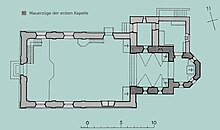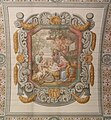Pilgrimage Church of Maria Licht
The Catholic pilgrimage church Maria Licht ( Romansh : Nossadunna dalla Glisch ) stands on the terrace of Acladira, a hamlet northwest of Trun in the Surselva in the Swiss canton of Graubünden .
history
At the place where the church stands today, a prehistoric place of worship or sacrifice is suspected. Processions around a large boulder until recently. The name-giving light phenomenon mentioned in the founding legend could also be an indication of this.
The first small church in Acladira was dedicated to St. Sebastian . Through a divine message, the pastor was induced to consecrate the new church to Mary. After the foundation stone was laid on April 27, 1663, the hill is said to have been illuminated by a bright light. The consecration took place on July 4, 1672 by Bishop Ulrich VI. de Mont in honor of the Virgin Mary to the light. The church was mentioned as early as 1666 under the name Beata Virgo Lucis Montanae.
Shortly after completion, pilgrimages began, which made an expansion of the chapel necessary in 1681. The new building with four altars was consecrated in 1684. The builder was Christian Netg. In the following years, the Gothic components were given a Baroque style and stucco and foliage .
construction
Exterior
The east-facing church consists of three parts: choir , vestibule and nave . The present antechamber in front of the actual three-sided choir formed the original nave of the chapel from 1672. The present nave was built between 1681 and 1684. At the same time, the bell tower and the sacristy in the east of the tower were built. The weekday chapel on the north wall was added in 1948.
The church tower is on the north side of the vestibule; the slender tip is finished with a pointed helmet over eyelashes . The roof turret above the choir is crowned by a curved hood.
inner space
From 1687 to 1690 the interior was lavishly painted by the church painter Fridolin Eggert from the Disentis Abbey ; the paintings are considered his main work. The picture in the choir canopy is remarkable, in which the flowing together of Mary's milk with the blood of her son in the offering bowl symbolizes her participation in the work of Christ.
- Ceiling paintings in the choir
On December 19, 1948, the wooden barrel ceiling with the ceiling painting fell victim to a fire. Thanks to old photographs, the restorer Karl Haag from Rorschach was able to completely restore the pictures.
The large fresco on the choir arch was created in 1687 and documents the importance of the Benedictine order . It shows a triumphal procession of Mary. The chariot is pulled by Benedictines; at the head is the founder of the order Benedict of Nursia . Behind them follow in ascending order of precedence holy monks, archbishops, cardinals and popes. The shackled prisoners behind the car symbolize heretics and schismatics .
The windows of the nave are decorated with images of the four church fathers and evangelists .
The original altarpiece of the high altar , a scene of the visitation , was replaced by a clothed Madonna in connection with the church expansion from 1681 to 1684. In the niches there are figures of Saints Martin (right) and Sebastian (left). The latter comes from the previous building in Acladira. The picture of the Visitation hangs in the weekday chapel today.
- ceiling
The two side altars were created after 1680. They show the Holy Family with Sebastian on the left, Anna and Joachim with Maria as a child on the right .
Brother Peter Solèr, a lay brother from the Disentis monastery, is considered to be the creator of the wooden pulpit from 1684 .
The Maria Licht Church has the largest collection of votive tablets in the Canton of Graubünden. The oldest date from when the first church was built around 1664. The old condition of the high altar is shown on some panels. The picture with the depiction of purgatory to the right of the entrance comes from Gertrud Januszewski and was created in 1950.
The organ has been renewed several times over the years; the first was from 1798, another followed in 1841. An organ from 1930 was destroyed in a fire in 1948; it was replaced in 1949. The current instrument was installed in 1993 by Orgelbau Kuhn from Männedorf .
Bells
The church has a three-part bell in the mood g, b and es. The oldest bell dates from 1643 and was probably cast by Mathias Albrecht in Chur . The other two were created in 1867 in the Grasmayr foundry in Feldkirch. In the ridge above the choir, there are two smaller bells, also by Grasmayr.
literature
- Peda art guide No. 17: Trun: Maria Licht; Passau 2003
- Erwin Poeschel : Kdm GR , Volume IV, Birkhäuser Verlag, Basel 1943; P. 425
- Ludmila Seifert, Leza Dosch: Art guide through Graubünden ; Scheidegger & Spiess, Zurich 2008, p. 221
Web links
- Maria Licht pilgrimage church at www.graubuendenkultur.ch .
- The pilgrimage church at Helvetia Catholica
- Description on outdooractive.com












